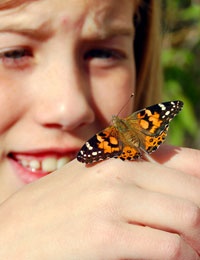Easy Wildlife Homes to Make in an Afternoon

For eco-friendly kids there's not much to beat watching wildlife outside your own back door and with habitat loss and changes in the countryside meaning that an increasing number of native British animals are visiting domestic gardens, the opportunities have never been better.
Creating a wildlife area is a great start, but if you really want to encourage visitors, there's nothing like offering a selection of ready-made homes to tempt them to stay. A quick visit to the average garden centre or good sized pet shop should turn up a whole variety of purpose built versions for sale, but if you prefer you can make your own. Many kinds can be made quickly and simply – often from recycled or natural materials, which is a real bonus for any family trying to live a greener lifestyle. Even with limited carpentry skills – and in some cases none at all – you can have a valuable wildlife home in a single afternoon. Here are a few examples of some of the easiest to build.
Logs And Leaves
For those of us who aren't particularly gifted when it comes to woodwork, logs and leaves offer a really simple way to get started – and best of all, even the littlest kiddie can get involved in building animal shelters this way.
Just assembling a pile of leaves in a quiet corner of the garden can provide a good home for a whole variety of small animals, from spiders and insects, through to larger creatures such as newts. Perhaps the most well-loved potential beneficiary, however, is the hedgehog – a pile of leaves offering a great source of nesting material. Add a nearby pile of logs and your hedgehogs will have found an ideal home to line with those leaves and make nests where they sleep during the day, their young are raised and in which they will eventually hibernate when the weather turns cold.
Birds, Bees And Butterflies
If you want to try something involving a little more actual carpentry, with a little wood, some nails and a few hand tools, you can soon be producing ideal homes for birds, bees and butterflies – though a spot of parental help may be necessary.
Homes for Bees
For reasons that aren't entirely understood, bee numbers around the world are declining, so making life easy for the ones in your garden can play a big part in helping these incredibly beneficial insects survive. Around 90 per cent of British bees are known as “solitary” – they live singly, not in hives or colonies like honey or bumble bees – and for a solitary bee, home is a suitably sized tube-shaped hole. You can buy “bee logs” which consist of lengths of hollowed out bamboo, set into a bored-out section of branch, but making your own is very easy. Just tie several lengths of bamboo or other suitable tubes together or alternatively, drill a series of deep holes around a quarter of an inch (6mm) in diameter into a small log and hang that up instead.
Even with the most rudimentary carpentry skills, you can soon knock a nesting box or a butterfly hotel together – and it's a great way to use up any off-cuts you have hanging around, provided they haven't been treated with any chemicals that might harm your intended guests.
Bird Box
There are plenty of DIY designs for bird boxes around, but they all basically come down to a simple wooden box with a suitable entrance hole in one side, so there's no need to feel you need to create anything too complicated. So long as their homes keep out the rain and the wind, the birds aren't too bothered about looks!
There are only two really important points to bear in mind. Firstly, make sure that you can get into your bird box for cleaning; having a hinged panel, lift-off roof or even using screws rather than nails for one side will allow you to open it up once a year. Secondly, remember that different kinds of birds prefer different sized holes. A 25mm entrance is ideal for blue tits, for example, while house sparrows like a bit more room, so make the hole around 32mm for them and robins need an open-fronted box.
Butterfly Hotel
Butterfly hotels are a similar idea – a basic box with an entrance, although in this case it needs to be a vertical slot rather than a round hole. It is a little more demanding project to do in terms of the woodwork involved, but it's well worth the effort. The easiest way to make the entrance is to drill two half inch (12mm) holes one above the other, about 3 inches (7.5cm) apart and then cut out the material between them with a coping or jig saw, using sand paper afterwards to smooth any roughness. Add two or three inches (5 – 7.5cm) of dowel below the slot to act as a perch, paint the exterior a bright colour and your butterfly hotel is ready to receive guests.
There's nothing quite like seeing a bee or a bird emerging from a shelter you've made for it, but do be warned – once you start building homes for wildlife, you may find it's a hobby that soon takes over! The good news, however, is that once you've run out of space for yet another bird box in your own garden, they're great eco-friendly presents for all your friends and family. Enjoy making yours.
Reproduced courtesy of www.ecofriendly kids.co.uk
